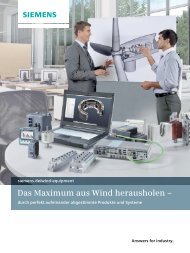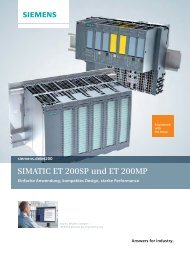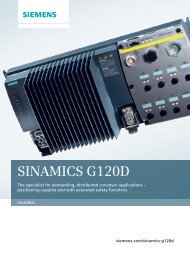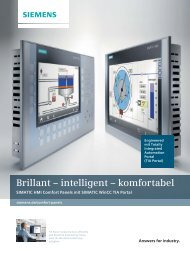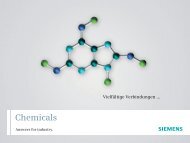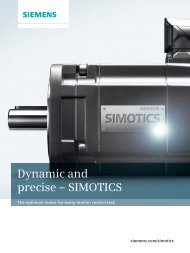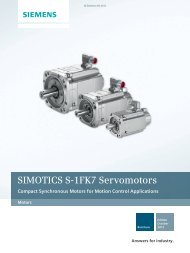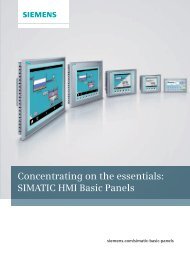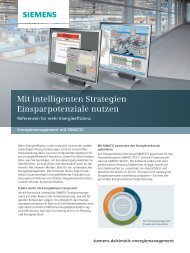Integrate safety - Siemens
Integrate safety - Siemens
Integrate safety - Siemens
Create successful ePaper yourself
Turn your PDF publications into a flip-book with our unique Google optimized e-Paper software.
The most important integrated <strong>safety</strong> functions<br />
for drives<br />
Description of possible application areas and advantages for the customer<br />
The implementation of <strong>safety</strong> concepts is based on the idea<br />
that <strong>safety</strong>-relevant events will first be recorded, then evaluated,<br />
and then responded to accordingly. An overview of the<br />
<strong>Siemens</strong> components available for this purpose can be found<br />
in the table on page 2.<br />
The drive-integrated <strong>safety</strong> functions can be roughly divided into two categories:<br />
Functions for safely stopping the drive without having to disconnect<br />
the connection to the mains. This includes the following<br />
functions:<br />
• Safe Torque Off (STO):<br />
This function ensures that no torque is released at the motor<br />
shaft any longer.<br />
• Safe Stop 1 (SS1):<br />
This function actively brakes a drive before the STO function<br />
is activated. In the event of danger, drives with a high<br />
kinetic energy can be brought to a standstill as quickly as<br />
possible using this function.<br />
• Safe Stop 2 (SS2):<br />
Like the SS1 function, the SS2 function actively brakes the<br />
drive. In a standstill, however, the SOS function is used instead<br />
of STO. Just as with SS1, drives with a high kinetic energy<br />
can be brought to a standstill extremely quickly in a<br />
hazardous situation.<br />
• Safe Operating Stop (SOS):<br />
As an alternative to STO, you can use the SOS function. In<br />
contrast to STO, the motor is not released from all torque.<br />
Instead, the drive remains in position control, holds its position,<br />
and it is monitored to detect zero speed.<br />
• Safe Brake Control (SBC):<br />
This function safely applies a holding brake after STO is activated,<br />
which means that the drive can no longer move,<br />
e.g. due to gravity.<br />
Functions for safely monitoring the speed of a drive:<br />
• Safely-Limited Speed (SLS):<br />
This function monitors the drive to detect if it exceeds one<br />
or more specified maximum speeds.<br />
© <strong>Siemens</strong> AG 2011<br />
Fail-safe drives are characterized by their "integrated <strong>safety</strong><br />
functions", which they provide to the user as possible responses<br />
to <strong>safety</strong>-relevant events. The most important integrated<br />
<strong>safety</strong> functions available for <strong>Siemens</strong> drives are described in<br />
the following. The functional <strong>safety</strong> of all of the functions satisfies<br />
the requirements defined in Part 5-2 of the international<br />
standard IEC 61800 for variable-speed drive systems.<br />
• Safe Speed Monitor (SSM):<br />
This function reports the failure to reach a specified speed.<br />
No drive-autonomous response occurs.<br />
• Safe Direction (SDI):<br />
This function monitors adherence to the selected direction<br />
of motion/rotation of the drive.<br />
Further additional <strong>safety</strong> functions are available specially for<br />
<strong>safety</strong> solutions in machine tools in connection with the<br />
SINUMERIK computerized numerical control.<br />
• Safely-Limited Position (SLP):<br />
This function prevents a specified position from being exceeded.<br />
With this function, a work area/protected area limitation<br />
or traversing range limitation can be implemented<br />
for specific axes.<br />
• Safe Cam (SCA):<br />
This function outputs a safe signal if the drive is within a<br />
specified position range. This function can be used to implement<br />
a reliable range recognition for specific axes.<br />
• Safe brake management (SB):<br />
Safe brake management consists of a safe braking signal<br />
and a safe brake test. The safely activated and tested brake,<br />
in combination with the safely monitored drive, results in a<br />
redundant stopping system for fall protection at vertical<br />
axes.<br />
• Safe programmable logic:<br />
Using safe programmable logic, it is possible to connect<br />
<strong>safety</strong>-related sensors and actuators directly to the control<br />
unit's I/O, without external evaluation units, and to evaluate<br />
them using software.<br />
The most important integrated <strong>safety</strong> functions for drives 5



